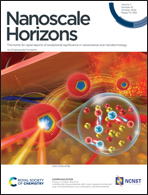Thermally driven phase transition of cobalt hydroxide sheets via cobalt oxides to cobalt nanoparticles†
Abstract
Transition metal oxides, which include many stoichiometric variations, are formed into various crystal structures by the atomic arrangement of cations and anions according to stoichiometric composition and are used for a wide range of applications based on this. Among them, cobalt oxide, which has wide crystal structures depending on the lattice points of the anion and the valence of the Co cation, from its hydroxide formula, is attracting a lot of attention due to its interesting catalytic properties due to its crystal structure. In this study, using the synthesized Co(OH)2 nanosheets, the real-time behavior of the phase transition that occurs when continuous heat is applied to the sample has been systematically analyzed using an aberration-corrected scanning transmission electron microscope. The layered Co(OH)2 phase passes through hexagonal CoO and cubic CoO phases to finally become Co nanoparticles, but when the temperature is dropped in the hexagonal phase, spinel Co3O4 is formed. These results suggest that various phases included in transition metal oxides can be selectively implemented according to temperature range control.

- This article is part of the themed collections: Nanoscale and Nanoscale Horizons: Nanoparticle Synthesis, Celebrating International Women’s Day: Women in Nanoscience and Nanoscale Horizons 2023 Lunar New Year Collection


 Please wait while we load your content...
Please wait while we load your content...